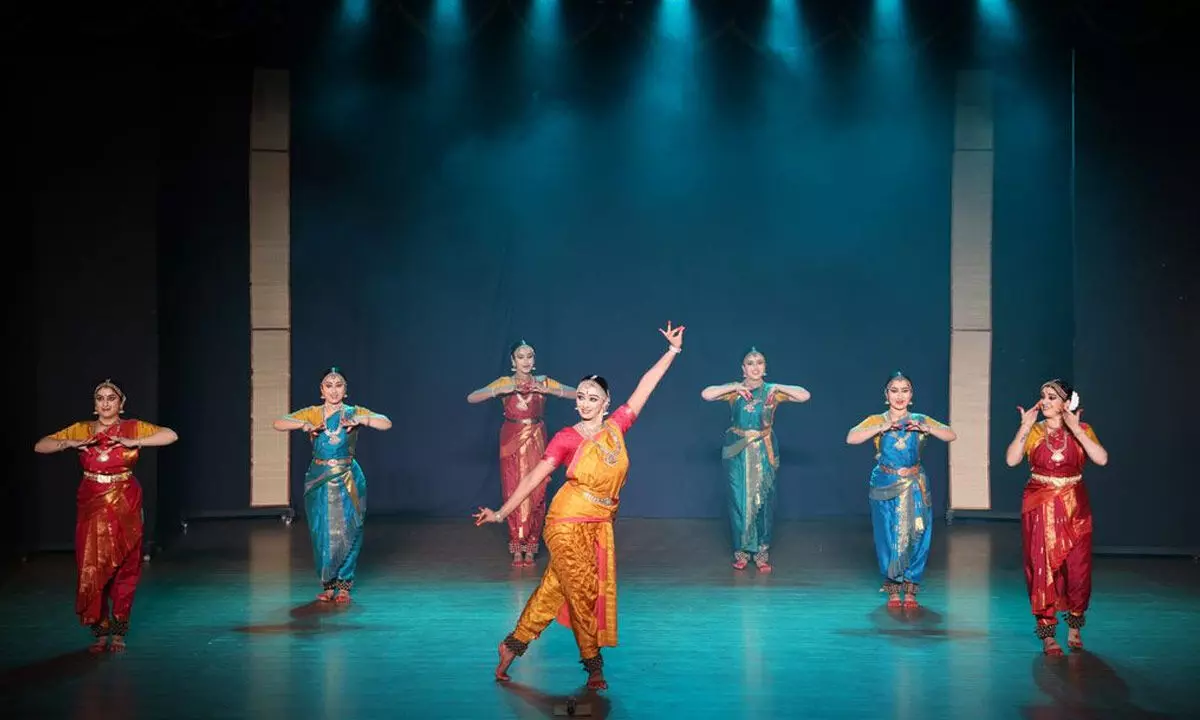A glorious celebration of Bharatanatyam

Dr Vyshnavie Sainath and her group delivered a breathtaking performance of “Manas Srotaha - Mindful Flow Through Dance” at the Annual Dance Festival 2024, hosted by SICA, held at Bharatiya Vidya Bhavan Auditorium. The recital showcased an exquisite blend of classical dance, yoga, and martial arts, highlighting Vyshnavie’s exceptional artistry and captivating stage presence
Recently South Indian Cultural Association (SICA) hosted its Annual Dance Festival 2024 at the Bharatiya Vidya Bhavan Auditorium this past weekend, presenting a captivating Bharatanatyam recital by Dr Vyshnavie Sainath and her group, titled “Manas Srotaha - Mindful Flow Through Dance.”
Dr Vyshnavie Sainath, a daughter and disciple of the renowned Bharatanatyam Guru Dr Rajeswari Sainath, has emerged as one of the finest exponents of classical Indian dance in her generation. Her extensive repertoire includes Bharatanatyam, Odissi, Kuchipudi, and contemporary dance, with performances spanning the globe. Vyshnavie’s unique ability to integrate yoga and martial arts into her performances, combined with her commanding stage presence, sets her apart as an extraordinary artist.
Adorned in a glowing orange-gold costume, Vyshnavie made her entrance to enthusiastic applause, her ornaments glittering and her presence likened to an exquisite golden sculpture adorned with sparkling gems. Her students, dressed in various vibrant colours, surrounded her like a multihued necklace, adding to the visual splendour of the performance.
The recital began with the “Laya Kadai” in ragam Hymavathi, a rhythmic ode to Lord Ganesha. This piece featured seven dancers, led by Vyshnavie, who explored the divine qualities of the deity. The composition, written specifically to fit the challenging mishra chapu talam, showcased the dancers’ exceptional skill and coordination.
The highlight of the evening was the solo “Navarasa Varnam” in ragamalika. Starting in Natakuranji and transitioning through Rathipathipriya, Rasikapriya, and Hamsadhwani, Vyshnavie displayed impeccable adavus and precise theermanam sequences. Her intricate jathis and measured gestures earned acclaim with every flourish, establishing her as a dancer’s dancer who rose superbly to the challenge of these ornate nritta sequences.
Rajkumar Bharathi’s music and Kavi Kannan’s lyrics provided the perfect backdrop for the performance. The depiction of sringaram (love) between Radha and Krishna was a blissful portrayal of divine romance. The adbhuta (wonder) was evoked during the swayamvaram episode from the Ramayana, where Ravana’s struggle to lift Shiva’s sacred bow contrasted with Lord Rama’s effortless feat.
The roudram (anger) rasa was powerfully depicted in the story of Hiranyakasipu and Prahlada, showcasing the fierce aggression of Lord Narasimha. Vyshnavie’s portrayal of the Man-Lion form of the Lord, tearing apart the Rakshasa King, was both intense and captivating.
Hasyam (humour) came to life in the story of Gundodara, the dwarf with an insatiable appetite, who devoured a wedding feast prepared for Shiva and Meenakshi. This episode was a delightful interlude of rib-tickling laughter.
The portrayal of veeram (valour) was exemplified in Arjuna’s archery contest, where he hit the eye of a rotating fish to win Draupadi’s hand. The remaining rasas—karuna (compassion), shantha (tranquillity), bibhatsa (disgust), and bhaya (fear)—were depicted with vigour and finesse, adding depth to the performance.
Students Geetha and Sangeetha performed a charming dual piece in matching violet and purple costumes, depicting a heroine coming to Krishna. The thillana in surya ragam was brisk and energetic, with Vyshnavie executing crisp movements in a celebration of pure nritta.
The grand finale was a fusion piece featuring the Australian Symphony Orchestra’s recording in kapi ragam. A tani avartanam between Thavil, played by Kalia Murthy, and Mridangam, played by Maestro Karaikudi Mani, provided a scintillating backdrop for Vyshnavie’s virtuoso display of pure dance. The students formed several tableaux, adding to the visual and auditory splendor.
Rajasekhar, Secretary of SICA, deserves commendation for his meticulous efforts in organizing this much-appreciated program. Dr Vyshnavie Sainath and her group delivered a performance that was both exhilarating and inspiring, leaving the audience in awe of their talent and artistry.














